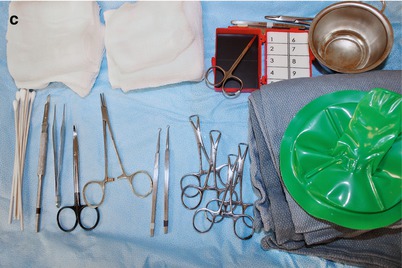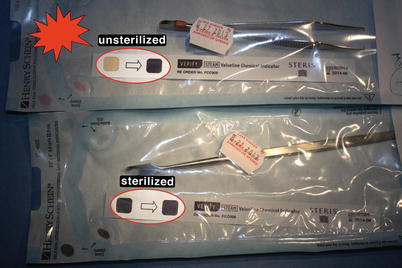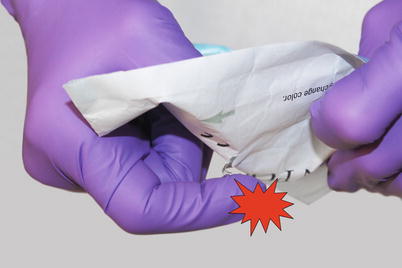
Fig. 2.1
Photos of tray setups for common office-based procedures. (Stock bottle and punch trephine wrapper are shown for clarity but should not actually be on the tray). (a) Shave removal. (b) Punch biopsy. (c) Excision
Solution 2
Anticipate special needs of the surgery that call for instruments not routinely placed on the tray (e.g., chalazion clamp for a lip procedure). Have these available on the tray before starting the procedure.
Solution 3
Have pre-arranged packages that contain all of the instruments necessary to perform a particular procedure (i.e., ‘punch biopsy bag’). An identifying label can be placed on the outside of this package to assist with accuracy.
Solution 4
If a surgeon only performs a limited range of procedures, having one generic tray will help with consistency and avoid the confusion of setting up several specialized trays.
Solution 5
Instruments should be catalogued properly when being stored. Individual sterile surgical instruments should be placed in designated bins.
Accidents Happen When
The surgical tray is too far from the surgical field.
Solution
Position the tray within arms’ reach between the surgeon and assistant.
Accidents Happen When
When non-sterile instruments are unknowingly placed on a surgical tray.

Fig. 2.2
Instruments should be sterilized before use. Blackening of the box on the indicator strip signifies sterility
Accidents Happen When
Instruments are removed carelessly from packaging. If a sharp instrument (e.g., toothed forceps or skin hook) is removed by tearing through the autoclaved pouch, the tips can puncture the skin (Fig. 2.3). Additionally, instruments can fall from the tray and puncture the foot.

Fig. 2.3
Puncture injury due to opening sharp instrument (here, a skin hook) through a pouch
Solution
Peel the plastic envelopes open like a banana so that the instrument can be gently dropped onto the tray.
Accidents Happen When
Trays are not set up consistently, especially when instruments are placed haphazardly on the tray.
Solution 1
Be consistent and organized in tray setup. All instruments should to be clearly visualized, easily retrieved, and placed safely back to their designated area. Consistency is important so that the team comes to recognize where sharps are kept.
Solution 2
Orient all instruments in a horizontal line with the sharp portion of the instrument facing away from the surgeon.
Solution 3
Place plastic organizing bins on the tray so that each instrument can lie neatly in its own respective column.
Common Safety Pitfalls of the Intraoperative Tray
Accidents Happen When
Reaching for an instrument in a messy tray. During a long or bloody procedure, gauze pads, suture packets, and other items obscure sharp instruments.









